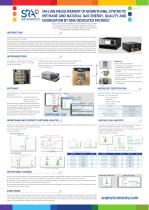
ON-LINE MEASUREMENT OF BIOMETHANE, SYNTHETIC METHANE AND NATURAL GAS ENERGY, QUALITY AND ODORIZATION BY ONE DEDICATED MICROGC
1 /
1Pages
Catalog excerpts

ON-LINE MEASUREMENT OF BIOMETHANE, SYNTHETIC METHANE AND NATURAL GAS ENERGY, QUALITY AND ODORIZATION BY ONE DEDICATED MICROGC Ronan COZIC1 | Pauline GUERIN1 | Christopher SAUER1 | Gianluca STANI2 2 1 Sra Instruments S.A.S. | 210 rue des Sources, 69280 Marcy l’Etoile, France Sra Instruments S.p.A. | via alla Castellana 3, 20063 Cernusco S/N (MI) Italy e-mail addresses | r.cozic@sra-instruments.com INTRODUCTION Biomethane is an important source of green and renewable energy. To allow injection of biomethane into the natural gas grid or the use as a vehicle fuel, it should meet the quality standards for natural gas. The timely and accurate measurement of the biomethane energy is of fundamental importance for users and distributors. The MicroGC technology supply features ideal for fast and accurate on-line analysis of biomethane and calorific value measurements. Minor organic contaminants like hydrogen sulfide, carbonyl sulfide, terpenes, ketones can be determined, as well biomethane odorization. As connection tool, an important role is played by the software architecture of the MicroGC system, it must be flexible and open to any specific installation requirement, like sampling switching, data communication and, at the same time, fully user accessible for data analysis management. The R990 M MicroGC from SRA Instruments Company is just starting its metrology certification process by the LNE (National Laboratory of Tests) according to the international recommendation OIML R140:2007 (OIML = International Organization of Legal Metrology), this will ensure the reliability and the reproducibility of the results, but also the reliability and the safety of the conditions of use. The metrology certification will concern the energy measurement of biomethane as well as natural gas with hydrogen. INSTRUMENTATION The analyzer uses the 990 channels from Agilent. This instrument can use from 1 to 4 MicroGC channel simultaneously. The 990 technology makes some differences compared to previous 490 platform by : • Improved channel design for easier exchange (less than 10 minutes) • Heated sample inlet and injectors • Better robustness. The use of fewer advanced connections limits diffusion and thus to extend the instrument’s operating time. • Integrated sensor for sample pressure alarm and monitoring within Soprane SW) • One dedicated inlet for the optional non-metrology channel • Inert membrane filter to ensure that no droplets nor particles enter in the injector • Temperature range for each channel : up to 180 °C and only isothermal Column With backflush • Possibility of having 1 or 2 carrier gases depending on the application A µTCD METROLOGY CERTIFICATION Inside the R990 is an on-board computer system driven by Windows 10 IOT. According to OIML R140 – Measuring systems for gaseous fuel Calculation : • SCV – volumetric basis Other specifications include : • Front panel touchscreen • Modbus : serial and/or TCP-IP • Wobbe index • Density or relative density The software used is a dedicated chromatography Data System for MicroGC providing function for automation and process application. Soprane CDS integrates calculations including those of the ISO 6976:2016 standard. Biomethane and Natural Gas including H2 International Standard for Calorific Values Calculation It is able to manage user and alarms. Its diagnostics is facilitated by the emission of log files and can handle many others (Automatic restart, stream selector, remote access…) Accuracy class ISO standard reference conditions Calorific value measurement range Environmental temperature BIOMETHANE AND SYNTHETIC METHANE ANALYSIS The analysis of all compounds contained in biomethane, or synthetic methane, requires a two-channel configuration : a CP-Molsieve 5Å for “light” gases and a PoraPlot U for hydrocarbons up to C3 and sulphur compounds. The analysis of natural gas (with or without hydrogen) uses a three-channel configuration : a CP-Molsieve 5Å, a PoraPlot U and a CP-Sil 5CB BF2D. Only one carrier gas is used : helium This channel can analyze compounds from C3 to C6+. All compounds after C6 are eluted in a single peak before the matrix peak Cycle time : 180 seconds Only one carrier gas is used : helium • Good linearity from 0.05 to 20 % Mol • Reproducibility calculated over 10 analyses THE OPTIONAL CHANNEL The two common odorant compounds in combustible gas are THT (tetrahydrothiophene) and TBM (terbutyl mercaptan), which are ideal for making a leak detectable. It is therefore necessary to prevent their concentration from being “below” or “above” the regular level, which requires thorough and monitoring The modularity of the instrument allows the choice of the module according to the odorant molecules added to gas. Thus, the CP Sil 19CB channel allows the quantification of THT while the CP Sil 13CB channel allows the quantification of TBM. On the other hand, some injection sites may require the monitoring of other compounds belonging to the terpene family. For this, the CP Sil 13CB channel is the best choice to control their content in the gas. CONCLUSION The previous version of metrology-certified instrumentation according to the same recommendations and standards, has already proved its worth. More than 150 analyzers from SRA have been installed for the on-line monitoring of injected biomethane. The new generation R990, with all its extended application range, will meet tomorrow’s requirements for the analysis of biomethane, synthetic methane and natural gas including hydrogen compound. The dedicated
Open the catalog to page 1All SRA Instruments catalogs and technical brochures
-
1088 Rotary Autosampler
2 Pages
-
1030S TOC
2 Pages
-
Aurora 1030W
4 Pages
-
Aurora 1030C
4 Pages
-
1080
8 Pages
-
SRA MicroGC Portfolio
6 Pages
-
Thermal Analysis Excellence
12 Pages
-
Thermal Analysis
40 Pages
-
NEW LAB SOLUTIONS
2 Pages
-
SRA R990
4 Pages
-
AG-OFGAS-35
2 Pages
-
NG 7040
2 Pages















